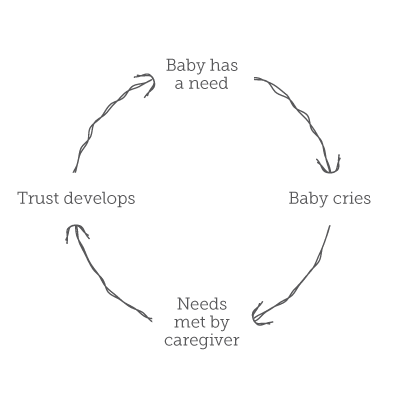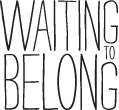A new definition of attachment/regulation
How emotional connections help children learn to moderate their behaviour
By Debi A. Grebenik, PHD
Psychoanalyst John Bowlby, drawing on concepts from ethology, cybernetics, information processing, developmental psychology and psychoanalysis, formulated the basic tenets of attachment theory. He defined attachment as the affectional tie between two people. It begins with the bond between the infant and mother. This bond then represents how the child's life relationships will be formed.
Bowlby stated, "The initial relationship between self and others serves as a blueprint for all future relationships."1 In other words, it is at this beginning stage that a baby learns how to relate to others. Initially, his or her world is very small and focused only on the parents or primary caretakers. Their response to the baby will determine the baby's ability to attach.
In attachment interactions between baby and mother, the secure mother regulates (calms) the baby's shifting arousal levels, which affects the baby's emotional states.2 If, during stressful events, a sustained calm stage can be reached due to parental soothing, the child develops self-regulation skills. The child begins to learn how to self-soothe, and these skills form the building blocks of healthy and significant future relationships. The ability to self-regulate and be regulated is a prerequisite to the ability to form healthy attachments.3
This process is easy to observe when a mother rocks, holds or bounces her child, perhaps coupled with a shushing sound while the baby calms. Some babies settle down just at the touch, smell or sound of their mothers.
Babies, children and youth who did not experience this soothing process find it difficult to calm down in moments of stress. These are the individuals who may react with only a minor provocation. An adolescent who begins yelling, cursing or crying when asked to complete a task or chore provides an example of someone who is not able to self-soothe. Attachment can thus be defined as the dyadic regulation of emotion.4
Bonding involves a set of behaviours that lead to an emotional connection, (which is also known as attachment).5 Understanding this process is key to helping a child with attachment disorder.
The positive interaction (needs-arousal) cycle
As we've mentioned, attachment occurs when the caregivers, primarily parents, provide stable and consistent responses to the child's distress. Distress occurs when a baby or child experiences hunger, fatigue, illness or any other type of discomfort.
An emotionally healthy adult delights in taking care of his or her baby or child. The mother and father respond to their child with eye contact, cooing sounds, physical snuggling and rocking movements. In turn, the child responds with smiling, gurgling, clinging, sucking and playing. This reciprocal interaction creates the basis for attachment. See the diagram below.6

Healthy attachment cycle
The safety and security that a strong attachment builds creates healthy cognitive, social, emotional and spiritual development for the child as he matures.
Children (biological or adopted) who do not get their needs met as babies and small children typically do not form a strong attachment with their parents. Even when adopting a baby, it is important to consider that the removal of a child from his or her biological mother creates a traumatic event in the life of the child.
One experienced mother, Amber Bartell, discovered this when she took little Amy into her home. As an infant, Amy had been passed from friend to friend by her mother. So when Amy was placed with Amber's family, bonding was anything but natural. In fact, Amy constantly pulled away from Amber. Whenever Amber tried to lay Amy on her shoulder, for instance, Amy held her body rigidly away from Amber. This continued until Amy was 11 months old.
So keep in mind that attachment with the new parents may not be automatic. Knowing this, parents need to understand not only the truth that establishing an attached, loving and committed relationship with their child is key, but also the fact that this may take some considerable time and effort. The adoptive parents' investment in fostering attachment can mitigate the trauma experienced by the child in the removal from her biological mother.
It is also important to note that adopted children (who suffer from attachment problems) may experience difficulties during certain developmental phases such as adolescence. These difficulties occur because of the youth's inability to meet her own needs. Out of her frustration, she might express her anger by yelling, hitting, vandalizing, threatening or withdrawing.
As well, the parent of an adopted child may have missed out on some significant aspects of attachment in his or her own upbringing. The adoption process thus may trigger unresolved emotions for the parents. It is important for parents to be self-aware, understanding the challenges and blessings of their own childhoods. When beginning the process to adopt a child, parents often prepare financially, physically and spiritually, without considering what effect the adoption will have emotionally.
Remember the family mentioned in the article entitled Attachment and bonding? By the time I saw them in family therapy, the situation had escalated and they were almost ready to dissolve the adoption. As we plowed through what was going on in their lives, we were able to discover the real issues. Throughout the mother's life, people at every stage had given up on her and cast her aside. That's all she knew in relationships – rejection.
Instead of responding as the parent when things became difficult with her son, she became that little girl and felt rejected once again. As the mother understood and expressed her pain and hurts, her heart began to mend, and her ability to feel and express love to her son began to swell. She experienced her son for who he was – a little child who needed her calm presence, realistic expectations, unconditional love and unlimited patience. She could now respond to his broken and wounded soul as his mother instead of as another broken child.
Through the power of prayer, processing pain with another person, and the presence of the Holy Spirit, healing can occur – both for the parent and the child. That is the quiet beauty of parenting hand in hand with God. This is also what gives hope; you can make a difference in the life of a child and, at the same time, you can become more of the parent God intends for you to be.
Next article in series: Dealing with Trust and Control Issues
First article in series: Attachment and Bonding
1. John Bowlby, Attachment and Loss. Vol. 1: Attachment (New York: Basic Books, 1969)
2. Allan Schore, "The Effects of a Secure Attachment Relationship on Right Brain Development, Affect Regulation and Infant Mental Health," Infant Journal of Mental Health, 2001, 22: 7–66
3. B. Bryan Post, The Great Behavior Breakdown, audio CD recording (Oklahoma City, OK: Post Institute for Family Centered Therapy, 2004). Postinstitute.com
4. L. Alan Sroufe, Emotional Development (New York: Cambridge University Press, 1995)
5. Bruce Perry, MD, Bonding and Attachment in Maltreated Children (Childtrauma.org), 2001
6. Adapted from a simpler diagram by Foster W. Cline, MD, Understanding and Treating the Severely Disturbed Child (Evergreen, CO: Evergreen Consultants in Behavior, 1979), 28
Excerpted from Handbook on Thriving as an Adoptive Family, a Focus on the Family book published by Tyndale House Publishers, Inc., © 2008 by Sanford Communications, Inc. Used with permission.
